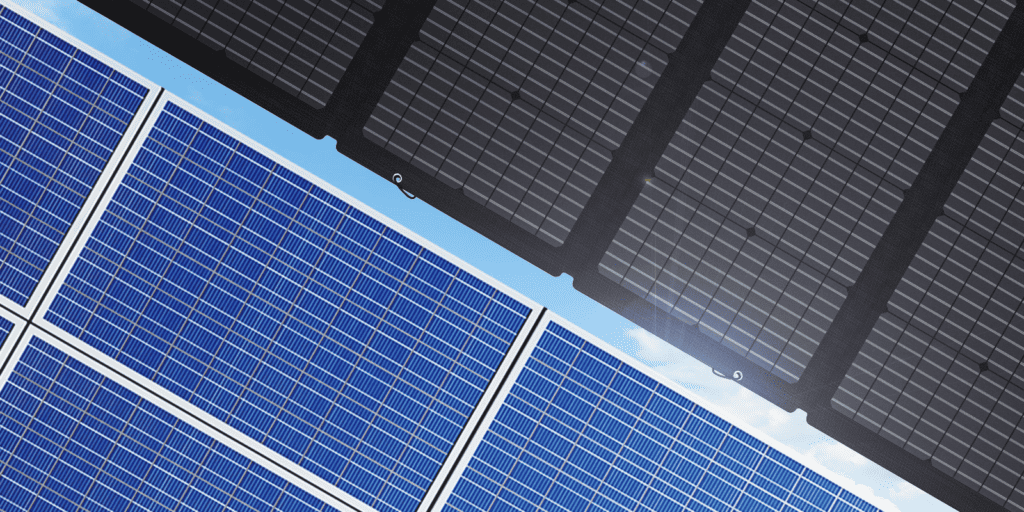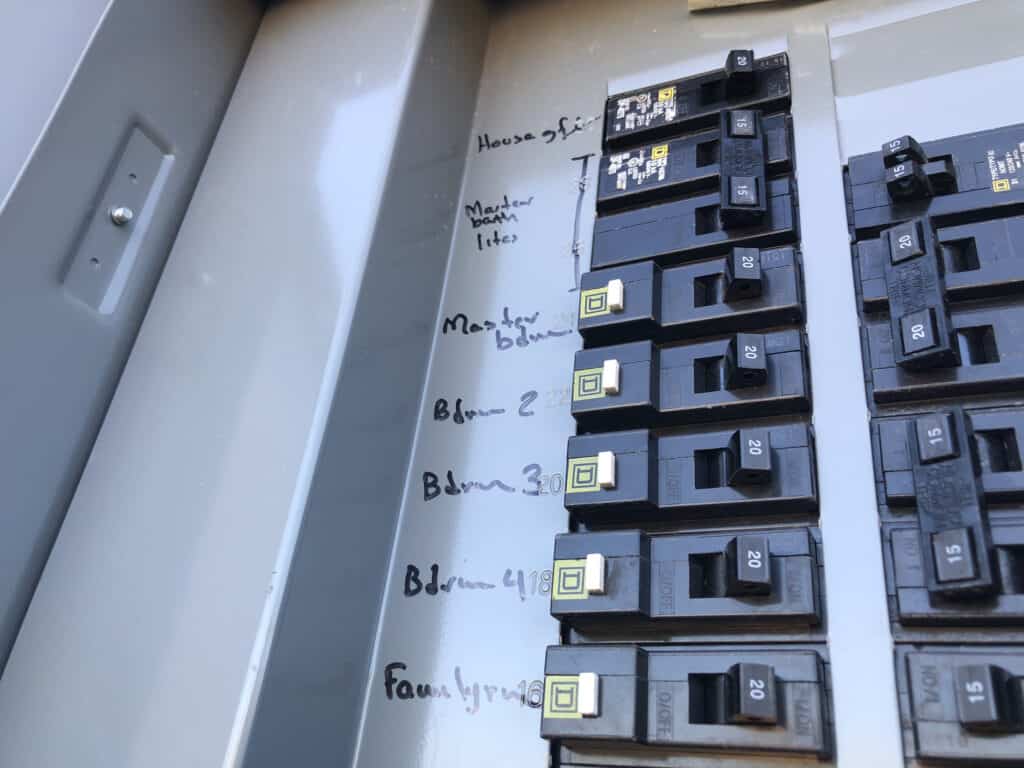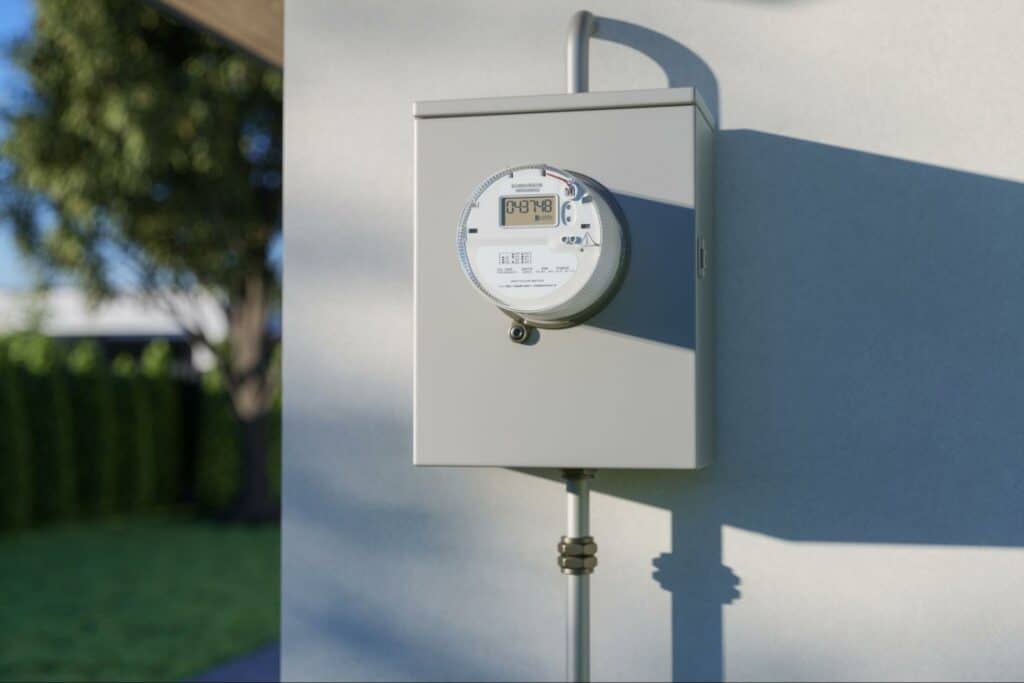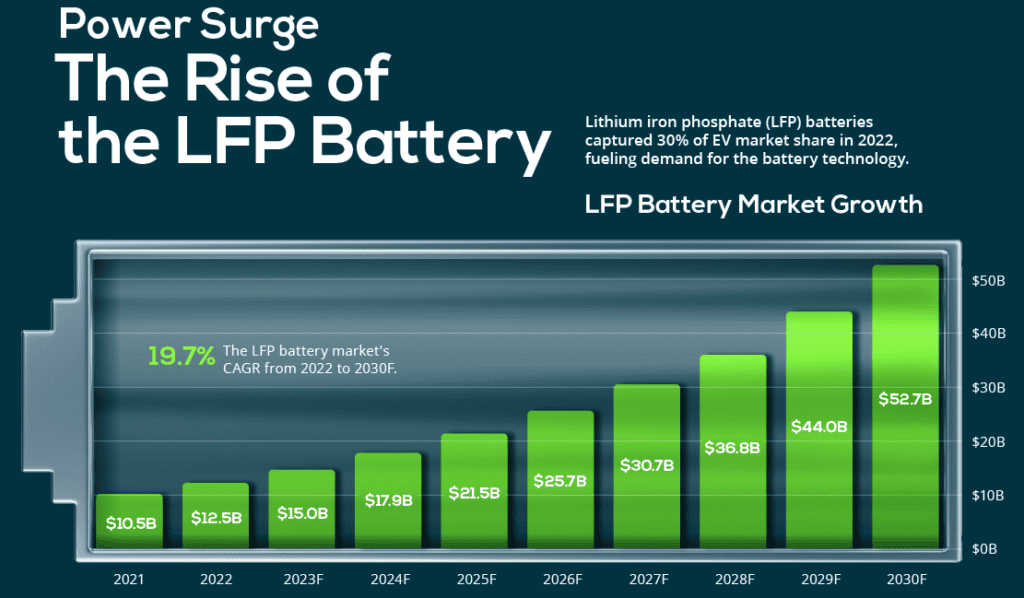Table of Contents
Are you considering a switch to solar and need 5kW of AC (household) electricity output to run your appliances and HVAC systems simultaneously?
One of your first big decisions is whether an on-grid or off-grid solar system better suits your needs.
Both typically use photovoltaic solar panels to capture the sun’s energy and additional components to convert it into usable electricity.
Off-grid offers energy independence, while grid-tied solar power systems reduce your reliance on your local utility but still require a connection to the grid.
Both options have their benefits — which choice is right for you depends on numerous factors, which we’ll cover below.
We’ll also explore the differences and similarities between the ideal components of a 5kW solar system — on-grid or off.
(Source: Electrical Academia)
What’s Needed for a 5kW On-Grid Solar System?
On-grid — or grid-tied — solar power systems require many of the same components as off-grid electricity solutions.
However, there are some crucial distinctions.
The essential difference between on-grid and off-grid systems is that grid-tied systems are connected to your local utility’s electricity grid.
Solar power, like wind, is a clean, renewable energy source. Both have enormous potential for generating electricity…
But they are both also intermittent energy sources:
- Solar panels don’t generate electricity at night, and the wattage they generate on cloudy days is lower than on days with several hours of peak sunlight
- Wind turbines produce little to no power in still weather
With grid-tied systems, the intermittency of solar power usually doesn’t matter. When your solar array fails to generate sufficient energy to meet your household’s electricity consumption, on-grid electricity seamlessly takes over to make up for the shortfall.
In some locations, you may even be able to sell excess electricity that you generate back to the utility through net metering programs.
Because on-grid systems don’t rely solely on the sun to produce electricity, solar batteries are optional. You might be left without power during a blackout…
But with off-grid systems, a solar battery is an essential component.
Let’s look at the other essential components of an on-grid solar system.

Photovoltaic (PV) Modules
Typically, this means solar (PV) panels. There are other options, such as solar shingles, but the vast majority of residential solar systems use some variation of solar panels.
Regardless of the manufacturer, solar panels come in three basic constructions.
- Rigid solar panels: Designed for permanent or fixed installation
- Flexible solar panels: Usually mounted and used to augment a rigid solar array by maximising the available surface area
- Portable solar panels: Setup/take down in minutes to take solar panels anywhere
The photovoltaic surface of the panels — which captures the sun’s rays — is comprised of solar cells, often hundreds of them. They are housed in a metal or plastic frame under a protective material — usually tempered glass.
Three types of materials are used to manufacture PV cells in residential solar panels.
- Monocrystalline silicon: The most efficient (and usually the most expensive) choice. Mono solar cells are carved from a single crystal of silicon. The manufacturing process generates considerable waste, contributing to the higher price tag. However, higher efficiency means the additional investment usually pays off over the long term.
- Polycrystalline silicon: Polycrystalline PV cells are made of multiple fragments of silicon rather than a single cell. There is little wastage in manufacturing, and the process is less expensive. This helps make poly solar panels cheaper than mono panels. But they’re also up to 10% less efficient — meaning they need to take up more space (and potentially more panels) to generate the same amount of electricity as monocrystalline.
- Thin-Film: Thin film panels are cheap but by far the least efficient. With efficiency ratings as low as 5%, they’re typically only used in specialised applications. Unlike mono and poly silicon PV panels, thin-film panels can be made from one or more layers of amorphous silicon, cadmium telluride, gallium arsenide, or copper indium gallium selenide thin photovoltaic film.
All three types of solar panels from EcoFlow are made from monocrystalline silicon solar cells and boast an industry-leading efficiency rating of +/- 23%. They’re universally compatible with on-grid and off-grid solar power systems from virtually any reputable manufacturer.
Cabling and Wiring
On or off-grid, a solar system that can generate and output 5kW of AC electricity will require a significant number of high-wattage rated power solar panels.
Make sure that the cabling, PV panels, and balance of the system you choose are all compatible. Choosing panels with near-universal solar connectors helps ensure system-wide interoperability, especially if you purchase individual components from different manufacturers.
Whether you’re connecting your solar panels in series or parallel, don’t skimp on the cables…
One bad wire can impact your whole array.
Solar Panel Mounting System
Fixed solar panel installations — such as those using 400W rigid solar panels — require mounting hardware, particularly for rooftop installations. The panels must be securely fastened to the roof to withstand high winds, blizzards, and other extreme weather events.
Many solar panel manufacturers will supply you with mounting hardware or offer you different options as an accessory at a nominal price. If you choose to work with a professional installer for either on-grid or off-grid solar arrays, you won’t have to worry about selecting mounting hardware.
If you prefer to mount your own solar panel array, make sure you select high-quality mounting hardware that can withstand the elements.
And be careful on the roof!
Grid-Tie Inverter (GTI)
Both on-grid and off-grid solar power systems use an inverter to convert the DC power captured by solar panels into AC (household) electricity.
But on-grid solar solutions must use an inverter that converts Direct Current to Alternating Current electricity that’s virtually identical to the power from the utility grid. In the UK, the AC power must be 230 V RMS at 50 Hz.
A GTI must also automatically disconnect from the grid in the event of a power outage. Isolating your PV system (and the electricity it generates) from the grid while it’s being repaired is crucial to ensuring the safety of electrical workers and preventing further damage.
Suppose you’re taking advantage of net metering (Smart Export Guarantee in the UK). In that case, the electricity you generate requires additional conditioning, such as matching the grid power’s sine wave AC waveform, to be safely fed back into the utility’s infrastructure.
All of this complexity means that on-grid solar power systems DO NOT make good DIY projects. To ensure your system is up to code and operates safely and effectively with the grid, you must work with a reputable installer and licensed electrician.

PV-Ready Distribution Board
As you doubtless already know, every home has an electric panel with circuit breakers, etc., that distributes electricity from the grid to different areas of your home and high-wattage appliances.
Depending on the age of your existing circuit board and wiring, you may need to purchase a smart electric panel that can process and distribute electricity from both your PV system and the grid.

Smart Power Meter
Depending on how your net metering program works, your meter may literally run backwards when you deliver electricity from your on-grid solar power system back to the grid.
If you have a traditional mechanical power meter, it may need to be replaced. Many utility companies will install a net metering-compatible smart power meter for free (or a nominal fee).
What’s Needed for a 5kW Off-Grid Solar System?
Off-grid and grid-tied 5kW solar power systems are similar, but crucial differences exist.
Some components (such as solar panels) operate the same way in both systems. Others (like the inverter) are similar, and some components (a solar battery or portable power station) are required for off-grid and optional for grid-tied systems.
Here are the components we covered above that operate identically in either type of 5KW system.
- Photovoltaic (PV) Modules (Solar Panels)
- Cabling and Wiring
- Solar Panel Mounting System
Below are the unique components of a 5kW off-grid solar system and a brief description of how the shared components vary from a grid-tied solution.
Inverter
In any photovoltaic (solar power) system, PV modules (typically solar panels) capture the sun’s energy and convert it to DC electricity. An inverter is required to convert DC power to usable AC (household) electricity.
Although they perform a similar function, off-grid inverters have far fewer restrictions and requirements than grid-tied inverters (GTIs). Because off-grid systems are, by definition, independent of existing electrical infrastructure, there’s no risk of the electricity processed by the inverter damaging the grid.
Having said that, you don’t want to skimp on an inverter. It’s an integral part of any off-grid solar system, and for reasons of safety and efficiency, you want the AC electricity it processes and feeds into your home to be “clean.”
Inverters can be purchased as separate components or as part of all-in-one solutions like EcoFlow’s Smart Home Ecosystem.
Important Note: One of the most crucial differences between grid-tied and off-grid solar systems is that you’re entirely reliant on the AC output (kW), storage capacity (kWh), and solar panel output of your off-grid system.
Five kilowatts (5kW) is a significant level of simultaneous AC output.
Even robust off-grid solar power solutions like EcoFlow’s Power Kits can only output 3.6 kW of running wattage simultaneously, and DELTA 2 Max offers 2400W (Surge 4800W) total AC output.
Only 2 x DELTA Pros chained together with a double voltage hub can output more than 5kW of operating electricity (7.2 kW/14.4 kW surge power with X-Boost).
If you want to achieve energy independence, consider whether you actually need 5kW of AC output. Add up the total starting and running wattage of all the appliances and HVAC systems you want to run simultaneously. If the total equals or exceeds 5kW of running wattage, a Smart Home Ecosystem could be the right solution for you.
You also have the option to only power a portion of your home off-grid — such as essential appliances during a power blackout or during peak hours to save on your electricity bill.
Either way, the next component is essential for off-grid solar systems.
Solar Battery
Solar batteries are optional in grid-tied systems for additional energy security. But in an off-grid PV system, a solar battery is essential. Solar power is intermittent. If you don’t store sufficient electricity to make it through the night — when solar panels don’t produce energy — your lights will go out.
Storage Capacity
Storage capacity is at least as crucial as AC output in off-grid systems. Calculate your solar panel output to ensure you have sufficient electricity generation capacity. Remember that a solar panel rarely generates its total rated power output in real-world conditions.
Once you’ve done that, calculate how much storage capacity you need. Storage capacity is typically measured in ampere-hours (Ah), watt-hours (Wh), or kilowatt-hours (kWh).
For example, EcoFlow’s solar generators and other off-grid power solutions all measure capacity in watt-hours (Wh) or kilowatt-hours (kWh). The DELTA series of portable power stations offer expandable storage capacity by adding additional batteries.
The Smart Control Kit with 2 x DELTA Pros and Smart Extra Batteries is expandable to 25kWh of electricity storage capacity.
Battery Chemistry
Understanding the basics of solar battery chemistry is essential to determining which off-grid 5kW solar system is right for you. The five battery chemistries most commonly found in residential solar systems are:
- Lead acid
- Nickel-cadmium (NiCd/NiCad)
- Lithium-ion (Li-ion)
- Nickel manganese cobalt (NMC)
- Lithium iron phosphate (LFP/LiFePO4)
Lead acid and nickel-cadmium battery chemistries date back to the 1800s and, for much of the 20th century, were the only rechargeable battery options available to consumers.
Though commonly found in older residential solar power systems, lead acid and NiCd batteries are rarely used in modern ones. Lithium-ion batteries have taken over as the chemistry of choice for most rechargeable battery-powered devices — from smartphones to Electric Vehicles (EVs).
Lead acid batteries may still be the cheapest option, but neither it nor NiCd can compete with the performance and longevity of lithium-ion batteries.
Nickel manganese cobalt (NMC) and lithium iron phosphate (LFP/LiFePO4) are newer subsets of lithium-ion battery chemistries with numerous advantages over traditional Li-ion batteries.

In particular, LiFePO4 (LFP) battery chemistry has seen rapid innovation and adoption in recent years — even in demanding applications like EVs.
Virtually all EcoFlow off-grid power solutions now feature LFP/LiFePO4 batteries which offer numerous benefits over older options. The primary benefits include:

- Cycle life of 3,000 full recharges/discharges without any noticeably diminished performance. That’s up to 10 years of daily use before you’re likely to realise the LFP battery’s storage capacity has decreased (to +/-80%). Reduced storage capacity doesn’t mean the portable power station won’t work. You’ll just have to recharge it more often.
Unlike other battery chemistries (like lead acid), chronological time has virtually no effect on an LFP battery’s lifespan. Cycle life is the best way to determine how long a LiFePO4 or other Li-ion battery type will last before it needs to be replaced.
- Faster recharge times: Up to 6x faster recharging using solar, AC, DC, or USB-C. Some portable power stations, like the DELTA 2 Max, even allow multi-charging and charge from 0-80% in just 43 minutes.
- Wide range of charging/operating temperatures
- Whisper-quiet operation
- Lightweight, compact, and durable
Solar Charge Controller
Solar charge controllers are another essential component of off-grid PV electricity solutions and typically come in one of two types: MPPT and PWM.
A solar charge controller regulates the DC current that travels from the solar panels to the portable power station or other balance of the system. It prevents the solar batteries from overcharging and power surges which can considerably shorten their cycle life — and in some scenarios, it can even be dangerous.
Like an inverter, a solar charge controller can be a standalone component or part of an all-in-one off-grid power solution like EcoFlow’s portable power stations.
For a 5kW system, an MPPT (Maximum Power Point Tracking) charge controller is highly recommended over PWM (Pulse Width Modulation). MPPT charge controllers are far more effective at supporting the large solar panel arrays required to generate 5kW of electricity.
Battery Management System
An advanced battery management system (BMS) optimises the performance — and prolongs the cycle life — of LifePO4 (LFP) solar batteries.
A 5kW off-grid solar power system carries a significant price tag. An advanced BMS like the one in EcoFlow’s portable power stations helps maximise your return on investment and achieve solar payback earlier in your system’s cycle life.
Once you’ve reached solar payback, all the money you save on electricity bills stays in your pocket!
An advanced BMS is a worthy addition to any off-grid solar power system.
Frequently Asked Questions
Calculating how many solar panels you need to generate 5kW per hour of electricity is not an easy feat. Start by looking up the average daily peak sun hours in your location. Using EcoFlow’s 400W rigid solar panel as an example, assume each panel will produce 75% of its rated power wattage for each hour of peak sunlight (300W). If your location receives 6 hours of peak sunlight on average, you would require about 17 PV panels to generate 5kW when they receive direct sun. Remember — no solar power system will produce 5kW 24 hours a day. If you use 5kWh of electricity every hour of the day and night, you must be living in a pretty big house. That would be 120kWh — about 12x as much as the average American household’s daily electricity consumption.
The term 5kW solar system is somewhat misleading. It indicates that the system can deliver 5kW of sustained AC output. However, for an off-grid system, it doesn’t show how long it can provide that level of output or how much energy your solar panels must produce to meet your household’s electricity consumption needs.
If you require an off-grid solar power system that can output 5kW of AC electricity, you must determine the following:
The portable power station or other balance of the system’s maximum AC output.
Total electricity consumption (kWh) per day
How many solar panels and solar batteries do you require to meet your total electricity generation and storage needs?
Final Thoughts
Five kilowatts of AC output is a significant amount of electricity.
If you live in an area where on-grid electricity is reliable, an on-grid solar power system is likely your best choice. A grid-tied system can use your utility’s power when your PV electricity generation falls short.
If you live somewhere where ageing infrastructure, remote location, or extreme weather events have made the electricity grid unreliable (or nonexistent), EcoFlow’s Smart Home Ecosystem is a viable solution. It’s capable of 7,200W (surge 14,400) of AC output and is expandable to 25kWh of storage.
Whether you opt for grid-tied or off-grid, government tax breaks and incentives can significantly offset the cost of switching to solar.
Carefully weigh up your home’s total daily electricity consumption to determine which option works best for you.







